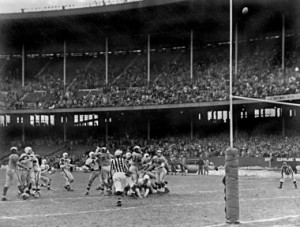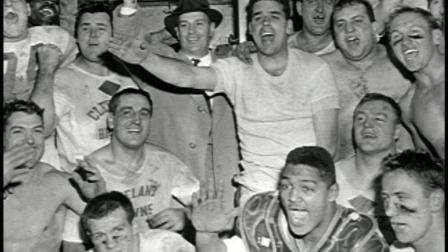Of the 1,010 games the Browns have played in the regular season and playoffs, the greatest Browns victory of all took place on this date, Christmas Eve, in 1950.
On the frozen field of Cleveland Municipal Stadium, amid Lake Erie winds of 28 mph, Paul Brown’s first NFL squad won the league championship in a dramatic 30-28 comeback over the Los Angeles Rams. The Rams were returning to Cleveland for the first time since winning their own NFL title five years prior as the Cleveland Rams.
At the end of World War II, the Rams headed west as the Browns were born in the All America Football Conference. Cleveland dominated the upstart league so thoroughly in the late ’40s that the lack of competitive balance hurt turnout and led to the AAFC’s demise. The Browns soon proved they were no second-rate outfit, as they dominated the two-time NFL champion Eagles in Philadelphia in their first NFL game.
They earned their way into the title game with a gutsy 8-3 win over the New York Giants, the only team to best the Browns (twice!) that season.
In the Rams, Cleveland’s stingy defense would face the most prolific offense of the era, a passing juggernaut with two Hall of Fame quarterbacks, Bob Waterfield and Norm Van Brocklin, and two Hall of Fame receivers in Tom Fears and Elroy Hirsch. In an age when rushing and defense dominated, the Rams averaged an astounding 38.8 points per game, still a league record. Their regular season statistics included 3,529 passing yards in 12 games, more than double the Browns’ total.
With the game’s very first play from scrimmage, that explosive reputation was made manifest. Halfback Glenn Davis, the former Heisman Trophy winner in his first pro season, beat linebacker Jim Martin on a wheel route. Waterfield connected deep down the left sideline, and the 82-yard touchdown (which set the record for the longest score in a title game) gave the Rams an early lead.
The twists and turns of this epic struggle were just beginning, and this fine history provides some vivid detail. In short, the Browns held the lead for a scant few minutes in the third quarter, and things looked dire when a fumble by Marion Motley, the NFL’s 1950 rushing leader, was returned for a touchdown that extended the Ram lead to eight points. The Browns were still down a point with with barely three minutes left when the game’s leading rusher, Browns QB Otto Graham, was hit from behind on a bootleg run and lost a fumble. But the courageous field general rallied his team with arm, legs, and head, setting up the famous Lou Groza field goal that supplied with winning points with 20 seconds to go.

The Toe’s clutch 16-yard field goal was no chip shot on a frozen field on which two previous kicks had failed that day.
The matter wasn’t decided, though, until the officials ruled that Browns defender Warren Lahr, and not the Rams’ Davis, had come down with Van Brocklin’s Hail Mary pass.
Statistically, Motley was held in check, but end Dante Lavelli excelled, with two touchdowns and 128 yards on 11 catches. Graham threw for all four Browns TDs and rushed for 99 yards.
Most significantly, though, was the Browns cementing their status as the undisputed best team in football.
Ponder how different things were back in 1950:
- Almost no players wore face masks. The Browns’ great defensive end Len Ford, returning for this game from a broken jaw, was a notable exception.
- Ball carriers were not necessarily whistled down when first taken to the ground.
- The title game was not televised in either Cleveland or L.A.
- A lower level grandstand seat could be had for $4.00, the equivalent of less than $40 today. Still, fewer than 30,000 fans braved the elements to witness the greatest Browns victory ever in the huge Lady on the Lake.
- The Browns roster was consisted of 33 players, of whom just five were African American.
- Neither team fielded a player with more than six years of experience.
- The Browns’ heaviest player, John Sandusky (no, not THAT one), weighed just 250 pounds.
- Only one Brown on the field that day survives: the great halfback Dub Jones, who turns 91 next Tuesday. He scored the first Browns touchdown of the day and gained 84 yards from scrimmage.
- And, yes, this should be said: the Browns were the classiest outfit in the league, not its laughingstock. No one was uncertain about the organizational hierarchy. Every man knew his job and trusted the others to do theirs well. The team represented the city in mind, body, and spirit.
Sixty-five years ago today, a jubilant Cleveland (at its peak population of 914,808) and its Browns were at the top of their game.
